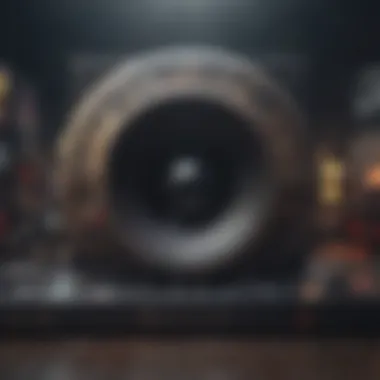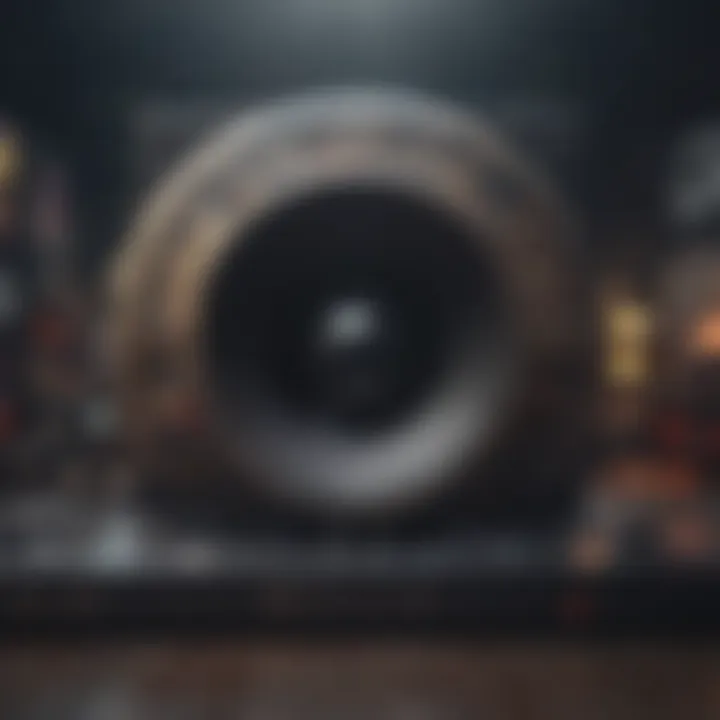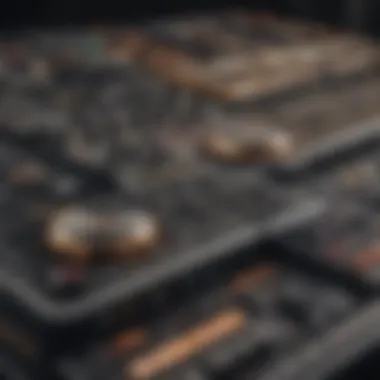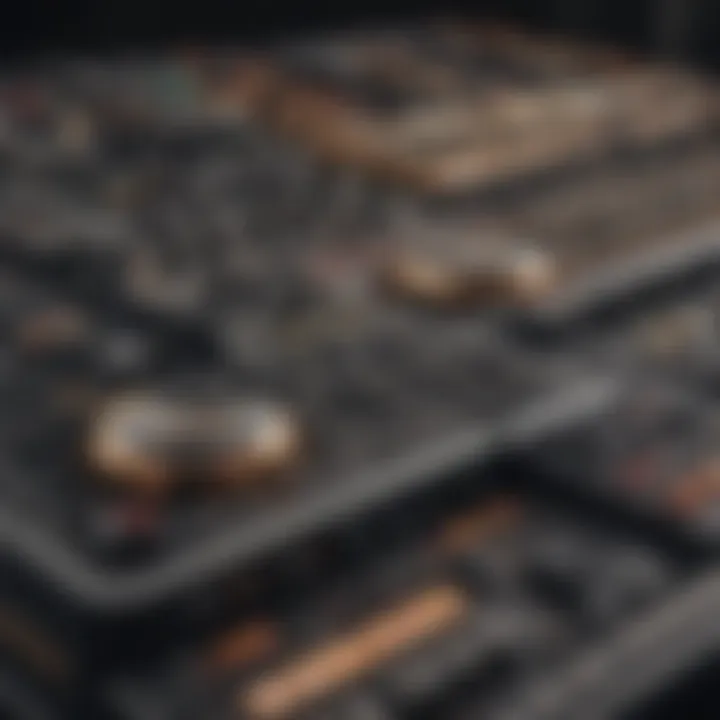Exploring the Evolution and Impact of Hip Hop Beat Generators


Intro
The realm of hip hop has increasingly embraced technology, particularly through the use of beat generators. These tools have allowed creators across the spectrum to produce, experiment, and refine their craft without the need for extensive formal training or access to expensive studio time. As such, understanding hip hop beat generators remains pertinent for artists, producers, and enthusiasts alike.
The landscape of these generators has evolved remarkably over the years, becoming more accessible and technologically advanced. This article will explore not just their features and evolution but also their impact on music production.
By examining the various types of beat generators, their technological foundations, and the way they cater to diverse demographics within the music industry, we aim to foster a comprehensive understanding of their significance.
Artist Profile
Biography and Background
The effective use of beat generators in hip hop has birthed many iconic artists. While the focus might be primarily on beats, understanding the artist’s background provides crucial context. Artists like J Dilla and Dr. Dre have greatly influenced the genre through innovative production techniques. Their unique approaches to beat making have inspired countless others.
We will highlight how these pioneers embraced technology and inspired future generations. Their biographies encapsulate elements of struggle, creativity, and evolution that resonate within the broader landscape of hip hop.
Major Influences and Inspirations
It's essential to recognize that the foundation of hip hop beat generation is built on influences from various musical genres.
- Sampling: Early hip hop beat makers often sampled jazz, funk, and soul records.
- Electronic Music: The rise of electronic music taught hip hop producers to utilize synthesizers and drum machines.
- Cultural Movements: The socio-political themes in hip hop often derive from real-life experiences, making the art form deeply personal yet universally relatable.
The interplay of these inspirations shaped the sound that became emblematic of hip hop, encouraging new artists to push boundaries.
Song Analysis
Theme and Lyrics Breakdown
To fully appreciate hip hop beat generators, an analysis of the songs produced using these tools is critical. Themes often explore a range of experiences, from social issues to personal storytelling. Lyrics serve as a critical component, marrying the beat with meaningful messages that resonate with audiences.
Instrumentation and Composition
Instrumentation within hip hop is defined by its variety and complexity. The incorporation of drum machines, synthesizers, and samples creates an intricate soundscape.
- Famous Instruments: The Roland TR-808 and Akai MPC series have been staples in beat making.
- Layering Techniques: Producers carefully layer sounds to create depth and richness in their tracks.
The composition of beats plays a fundamental role in how each song communicates its message.
"The evolution of hip hop beat generators reflects not just changes in technology but also shifts in cultural narratives. " - Musicologist
Preface to Hip Hop Beat Generation
The world of hip hop is multifaceted and constantly evolving. At its core, the beat is the backbone of hip hop music, setting the tone for the genre. Understanding beat generation is crucial for anyone interested in music production or the artistic process of creating hip hop. This section aims to outline the significance of hip hop beat generators, highlighting their influence in contemporary music production.
Defining Hip Hop Beat Generators
Hip hop beat generators are tools used to create the rhythmic and melodic foundation of hip hop tracks. They come in various forms, including hardware samplers and software applications. These generators allow producers to manipulate sounds, arrange beats, and layer different audio elements. Some of the common features include drum programming, sound libraries, and intuitive interfaces that facilitate creativity.
In the current landscape, beat generators play a significant role in both amateur and professional music production. They empower musicians by providing accessible means to craft beats without requiring extensive knowledge of traditional musical instrumentation. This democratization helps broaden the horizons for aspiring artists and producers.
Historical Context of Beat Generation
The history of beat generation in hip hop is essential to understanding its current state. In the early days of hip hop, beat-making primarily relied on live performances and sampling from existing records. Pioneers like DJ Kool Herc innovated by using turntables to mix and loop beats, laying the groundwork for modern production techniques.
As technology advanced, so did the tools available for beat making. The introduction of drum machines in the 1980s, such as the Roland TR-808, revolutionized music production. These machines allowed musicians to create polished beats with ease. The shift from analog equipment to digital software in the late 1990s marked another significant turning point. With the rise of digital audio workstations (DAWs), beat generators became more sophisticated, offering a wider range of sounds and functionalities.
This historical evolution has shaped current beat-making practices and has greatly influenced the sound of contemporary hip hop. In essence, understanding the historical context of beat generation provides valuable insights into how these tools develop and cater to the needs of today's artists.
The Evolution of Beat Technology
The evolution of beat technology is critical in understanding how hip hop production has transformed. This progression reflects broader changes in music consumption, creativity, and industrial practices. Each phase of this evolution introduces innovative tools that expand the possibilities for artists and producers, making music more accessible and personalized.


From Analog to Digital
The journey from analog to digital technology marked a pivotal shift in music production. Prior to digital advancements, beat-making was largely dependent on analog instruments and tape machines. This made the process slower and required more technical know-how. Artists had to rely on physical equipment, which, although rich in tonal warmth, posed limitations on experimentation and editing.
With the introduction of digital technology, the landscape underwent a significant transformation. Digital audio workstations (DAWs), such as Ableton Live and FL Studio, revolutionized the way beats were created. They allowed producers to record, edit, and arrange sounds with ease. The advent of MIDI (Musical Instrument Digital Interface) enabled musicians to connect different instruments electronically, opening up new creative avenues. Digital sampling became easier, allowing producers to incorporate diverse sounds from various sources without compromising quality.
Benefits of this transition include enhanced flexibility and efficiency. Now, adjusting tempo, pitch, or sound layers could be done with just a few clicks. This democratization of music production made it possible for a broader range of artists to enter the hip hop scene, regardless of their technical background.
The Rise of Software-Based Generators
The rise of software-based beat generators has fundamentally reshaped the production landscape in hip hop. These generators, like Maschine by Native Instruments and GarageBand by Apple, provide powerful tools for artists to create beats without the need for extensive recording equipment. They come equipped with user-friendly interfaces and a myriad of features that allow for both novice and experienced producers to experiment easily.
Software-based generators offer several advantages:
- Accessibility: Many software solutions are reasonably priced or even free, making them appealing for hobbyists and aspiring artists.
- Portability: Producers can work on beats from various devices, whether at home or on the go.
- Extensive Sound Libraries: These tools often provide vast libraries of samples, loops, and synth sounds, fostering creativity and experimentation.
- Collaboration: Online capabilities facilitate easier sharing and collaboration among artists, contributing to creative exchange and innovation.
The impact of software-based beat generators cannot be overstated. They have empowered a new generation of producers, allowing them to push the boundaries of hip hop music. As technology continues to evolve, the potential for new forms of expression within the genre seems limitless.
Types of Hip Hop Beat Generators
Understanding the different types of hip hop beat generators is essential for music enthusiasts, aspiring musicians, and students. Each type offers unique features and benefits, catering to various creative approaches in music production. This section will detail three main types of beat generators: loop-based, sample-based, and real-time generators. By comprehension their functionalities, one can make informed decisions when selecting a generator for their projects.
Loop-based Generators
Loop-based generators serve a fundamental role in beat creation. They provide users with a collection of rhythmic loops that can be combined, modified, and arranged to construct a full track. The key advantage of these generators is efficiency. Musicians can rapidly assemble beats with little technical knowledge. Additionally, they foster creativity by allowing users to experiment with different combinations of loops.
Several popular loop-based generators exist in the market such as Ableton Live, FL Studio, and GarageBand. Each tool comes equipped with various loop libraries tailored to different genres, including hip hop. In choosing a loop-based generator, considerations include:
- Library size: A larger library provides more options.
- Customization ability: Look for generators allowing alteration of loops.
- Intuitive interface: Ease of use often promotes better creative output.
Sample-based Generators
Sample-based generators focus on utilizing pre-recorded audio samples to produce beats. These samples can range from snippets of songs to sounds recorded from everyday life. The diversity and richness of samples can lead to a more organic sound, reflecting the character of hip hop culture. Sample-based generators, like Native Instruments' Maschine or Akai Professional's MPC series, offer comprehensive sampling capabilities that allow users to manipulate audio clips.
Key aspects of sample-based generators include:
- Vastiity of samples: Diverse samples influence creative directions.
- Editing tools: Ability to trim, stretch, and manipulate audio clips enhances versatility.
- Integration: Ensure compatibility with other production software for optimal workflow.
Real-time Generators
Real-time generators provide an interactive approach to beat making. They allow musicians to create beats on-the-fly, which can be particularly useful during live performances. These generators enable users to trigger sounds and loops instantaneously, fostering a spontaneous and dynamic production environment. Tools like Novation Launchpad and Akai Fire exemplify real-time beat-generation technology.
What to consider when using real-time generators includes:
- Latency: Minimal delay is essential for smooth performance.
- User interface: A clear interface facilitates quick access to sounds and features.
- Playback options: Multiple playback methods add to the creativity during live sessions.
By recognizing these types of hip hop beat generators, users can harness their unique capabilities to enhance their music production process. Whether you prefer loop-based simplicity, the richness of samples, or the dynamism of real-time creation, there is a generator that fits your needs.
Key Features of Beat Generators
Understanding the key features of beat generators is essential for anyone delving into hip hop production. These features not only influence the creativity of the music produced but also determine the ease of use for aspiring musicians. There are notable characteristics that one must consider when evaluating different beat generators.
User Interface Design
The user interface (UI) of a beat generator is the first point of interaction and significantly shapes the overall experience. A well-structured UI provides intuitive navigation and clear visual feedback, allowing users to focus more on creativity rather than getting lost in complexities. Important elements include:
- Layout: Clean layouts discourage confusion and enhance productivity. A logical arrangement of tools promotes efficiency in beat-making.
- Visual Responsiveness: UI elements should respond quickly to user inputs. This responsiveness encourages experimentation, which is vital for creativity.
- Accessibility Options: Accessible UIs cater to various user abilities, promoting inclusivity in music production.
Overall, an engaging user interface not only makes the process enjoyable but also reduces the learning curve for new users.
Sound Libraries and Samples


Sound libraries play a crucial role in beat generation. They provide a diverse array of sounds that can stimulate creativity and enhance the sonic quality of music production. Key aspects of sound libraries include:
- Variety of Genres: A good library contains samples that span several genres, particularly those that are integral to hip hop, such as funk, jazz, and soul.
- Audio Quality: High-quality samples ensure that the final mix sounds professional. Poor-quality sounds can tarnish the overall production.
- Regular Updates: Providers who keep their libraries fresh with new sounds and samples give users access to the current trends in music production.
Having robust sound libraries and samples enables musicians to explore new sounds and styles while crafting their beats.
Customizability and Flexibility
Customizability is a feature that stands out in beat generators. The ability to modify sounds and parameters allows producers to create unique beats tailored to their preferences. Important considerations include:
- Editing Tools: Advanced editing tools let users manipulate pitch, tempo, and effects. This flexibility can turn a simple loop into a complex composition.
- Integration with Other Software: Compatibility with Digital Audio Workstations (DAWs) enhances workflow, allowing for seamless transitions between various production stages.
- User-Defined Settings: The option to save presets or custom templates enables quick access to preferred setups, saving time during the creative process.
In summary, the customizable elements in beat generators empower musicians to work within their unique stylistic frameworks, thus enhancing their artistic expression.
"The right beat generator can transform an idea into a fully realized track, making it significant in the creative workflow."
The aforementioned features—user interface design, sound libraries, and customizability—are fundamental to understanding the functionality of beat generators in the hip hop context. They offer the essential tools needed for both new and experienced producers.
The Role of Beat Generators in Hip Hop Production
Hip hop production has undergone significant changes in recent decades, largely due to the advent of beat generators. These tools have transformed how music is created, offering both efficiency and creativity to producers at all levels. Understanding the role of beat generators is crucial, as they not only provide the foundational sound but also influence the artistic expression within hip hop.
Influence on Beat Making
Beat generators hold a prominent position in the creative process of music production. Unlike traditional methods that may rely heavily on live instruments or samples from vinyl records, beat generators allow producers to experiment with sounds in real-time. They facilitate the layering of various sounds, samples, and loops, creating a rich tapestry that forms the backbone of each track.
The influence of beat generators can be seen in several ways:
- Accessibility: With beat generators, aspiring musicians can produce high-quality beats without needing expensive studio time. This democratization has enabled many new artists to emerge.
- Creativity: Producers can manipulate sounds with a few clicks. Changing tempo, altering pitch, and adding effects become straightforward tasks. This encourages more experimentation, resulting in unique styles that may not have been possible otherwise.
- Speed: Beat generators enable rapid production cycles. This is particularly important in a genre that thrives on timeliness and relevance. Artists can quickly produce beats that resonate with current trends.
In summary, beat generators have become a vital part of the hip hop production landscape, shaping how beats are created, presented, and consumed.
Integration with DAWs
Digital Audio Workstations (DAWs) are integral to modern music production. The compatibility between beat generators and DAWs further enhances the production capabilities for hip hop artists. Most beat generators seamlessly integrate with popular DAWs like Ableton Live, FL Studio, and Logic Pro. This integration simplifies the workflow for producers, allowing them to transition between creating, arranging, and mixing more fluidly.
Key points in this integration include:
- Direct Importing: Producers can easily import their generated beats into their DAW of choice. This eliminates the need for manual file transfers, saving time and effort.
- Layering and Editing: Once imported, these beats can be modified in the DAW environment. Producers can add effects, slice samples, and arrange tracks without limitations.
- Collaboration Opportunities: The pressing need for collaboration in today’s music industry is supported by this integration. Producers can work together in real-time, sharing ideas and edits instantly within their DAWs.
"The synergy between beat generators and DAWs has revolutionized the way music is made, fostering collaboration and creativity like never before."
In essence, the role of beat generators in hip hop production cannot be overstated. They serve as both instruments of creativity and catalysts for efficient music-making, driving the genre forward.
Cultural Impact of Beat Generators
The advent of hip hop beat generators marks a significant shift in music production, largely influencing contemporary culture. These tools do not just aid musicians in their craft; they also reshape the way music is created, shared, and enjoyed. The cultural impact extends beyond the technical aspects of music production to the very essence of art, accessibility, and community.
Democratization of Music Production
Hip hop beat generators have played a critical role in making music production more accessible to a wider audience. Unlike traditional methods that required significant financial investment and technical expertise, these tools allow anyone with a computer or a tablet to create and manipulate beats. This ease of access fosters creativity and encourages experimentation among aspiring producers and musicians.
With free or low-cost software becoming increasingly available, many individuals can now produce high-quality sounds without the barrier of costly studio time. This opens up opportunities for diverse voices and perspectives in music—a vital factor in a genre born from underrepresented communities. Artists from various backgrounds can experiment with their styles and sounds, contributing to a rich mosaic of influence that defines hip hop today.
Furthermore, platforms such as BandLab and Soundtrap enable collaborative efforts among musicians, breaking down geographic barriers. Now, an artist in New York can effortlessly collaborate with a producer in Tokyo, enriching the genre with a global influence that was once unimaginable.
Shift in Music Consumption Patterns
The way audiences engage with music has also evolved, thanks to the proliferation of beat generators. The convenience of creating music at home leads to a surge in home studios. With the democratization of music production, fans can now transition from mere listeners to active creators. This shift encourages a more interactive relationship with music, as people immerse themselves in the process of creation.
Moreover, this transformation in music consumption is visible in the rise of platforms like SoundCloud and YouTube, where independent creators can upload their beats and tracks. Users not only consume music but also participate in challenges, remixes, and collaborations directly on these platforms. This reflects a cultural embrace of user-generated content, where artistry is not restricted to established talents but is open to anyone willing to express their creativity.


"The availability of hip hop beat generators signifies more than just technology; it represents a cultural evolution that empowers voices previously silenced in mainstream music."
Choosing the Right Beat Generator
Choosing the right beat generator is a pivotal decision for anyone involved in hip hop production. With numerous options available on the market, each offering unique features and functionalities, selecting an appropriate tool can significantly affect the quality and efficiency of music creation. Every beat generator comes with its advantages and drawbacks, making it essential for users to understand specific elements that will influence their creative process and final output. Factors such as user experience, sound quality, flexibility, and compatibility with other music production tools are critical to consider.
Moreover, the right generator can cater to individual styles and preferences, enhancing artistic expression. For beginners, an intuitive interface may be crucial, while seasoned producers may prioritize advanced features and sound libraries. Choosing wisely ensures that the beat generator aligns with one’s goals, whether it is for professional production or personal experimentation.
Factors to Consider
When looking for a beat generator, musicians should bear in mind several key factors:
- User Interface: A user-friendly interface can make a significant difference in how effectively a producer can work. Search for platforms that provide clear navigation and an organized layout.
- Sound Quality: The quality of sounds included in the generator is paramount. Listen to demos whenever possible and ensure the generator produces high-fidelity audio.
- Customization: A generator that allows users to modify sounds, build their unique beats, or create samples is more versatile. Look for features that enable extensive customization.
- Compatibility: Ensure the chosen generator works seamlessly with your Digital Audio Workstation (DAW) of choice. Compatibility ensures smooth integration into your workflow.
- Support and Community: A strong support system or active user community can assist users in troubleshooting and sharing techniques. Look for resources, tutorials, and forums that provide robust aid.
By carefully considering these factors, musicians can choose the right beat generator that suits their specific needs, fostering creativity and productivity in their projects.
Popular Beat Generators in the Market
Several beat generators stand out due to their features, popularity, and user satisfaction. Here are a few notable ones:
- FL Studio: Renowned for its powerful mixing and extensive sound library, FL Studio is suitable for both beginners and professionals.
- Ableton Live: With its session view and flexible interface, Ableton Live is favored by many producers for live performances and beat-making.
- Logic Pro X: Another professional-grade option, Logic Pro X offers a comprehensive suite of tools, perfect for Mac users.
- Maschine: Native Instruments’ Maschine blends hardware and software effectively, providing a hands-on approach to beat creation.
- GarageBand: A free choice for Mac users, GarageBand offers an accessible entry point for those looking to start producing beats conveniently.
"Selecting a beat generator is not just about features; it is about how those features empower your creativity."
Future Trends in Beat Generation Technology
The landscape of music production is ever-evolving, particularly in the realm of hip hop beat generation. Understanding future trends in beat generation technology is crucial for music enthusiasts, aspiring musicians, and students. These trends will likely define how beats are created, shared, and experienced in the years to come. The integration of advanced technologies offers numerous benefits, including increased accessibility, enhanced creativity, and the potential for limitless experimentation. This section explores two significant trends: AI and machine learning applications, and the role of virtual reality in beat creation.
AI and Machine Learning Applications
AI and machine learning are starting to play a vital role in beat generation. Developers use algorithms to analyze existing music patterns and styles, which allows them to create beats that mimic popular genres or even generate unique sounds. This capability can save time for producers who may struggle with creativity or decision fatigue when selecting samples or building drums.
The advantages of AI in music production are abundant:
- Efficiency: AI can quickly generate multiple options based on parameters set by the user.
- Versatility: It can adapt to different genres and styles by learning from various datasets.
- Creativity Boost: AI can suggest unexpected combinations that a human user might not consider.
Applications like OpenAI's MuseNet or Amper Music provide tools where users can input parameters like mood or genre, and the AI generates suitable beats. While human touch remains essential for infusing emotion and context into music, AI serves as a robust collaborator that can push creative boundaries.
AI will reshape how beats are made. It opens doors to experimentation that were closed before.
Virtual Reality and Beat Creation
Virtual reality (VR) is another exciting frontier in beat generation technology. It offers a unique way for musicians to engage with their music by immersing them in a three-dimensional space. In this space, users can manipulate sounds and arrange beats through gestures and movements.
Some noteworthy aspects of VR in beat creation include:
- Immersive Experience: Musicians can engage with their beats in a more tactile manner, potentially leading to richer interactions with their music.
- Collaboration: VR enables remote collaboration, where multiple musicians can join a virtual studio to create music together, regardless of physical location.
- Educational Opportunities: VR can facilitate practical learning experiences for music students, allowing them to experiment with sound design and arrangement in an interactive way.
Platforms such as VRChat and Horizon Worlds are starting to integrate music-making tools in their virtual environments. As technology advances, the accessibility and functionality of VR for beat generation will likely increase, ushering a new way to craft and experience music.
Both AI and virtual reality signify a shift towards highly customizable and interactive beat-making processes. As these technologies mature, they have the potential to change not just the production methods, but also the way audiences connect with hip hop and its evolving soundscape.
Epilogue
In summing up the discussion around hip hop beat generators, it is clear that these tools play a pivotal role in shaping modern music production. They not only provide accessibility to aspiring musicians but also reflect the evolving landscape of music technology. Understanding hip hop beat generators helps artists make informed decisions that align with their artistic visions and needs.
Summary of Key Insights
The exploration of hip hop beat generators reveals several important insights:
- Accessibility: These tools have democratized music production, allowing anyone, regardless of background, to create beats.
- Diversity: Different types of generators cater to various user preferences, from loop-based systems to sample-based creation, making them highly adaptable.
- Technological Advancement: The integration of advanced technologies such as AI is shaping the future. This influence will likely increase as music production continues to evolve.
- User Experience: A well-designed user interface is crucial for both new and experienced users, impacting creativity and efficiency in the beat-making process.
Final Thoughts on the Evolution of Beat Generation
The evolution of beat generation technology, from analog origins to sophisticated digital platforms, illustrates a remarkable journey. Today’s beat generators not only reflect technological progress but also serve as a canvas for artists to express creativity.
As we move forward, the potential for innovation in this field promises to unlock new avenues for musical exploration. Tools that integrate AI and machine learning will increasingly offer personalized experiences, tailoring soundscapes to individual tastes.
Keeping an eye on these future trends can significantly benefit musicians and producers alike, ensuring they remain at the forefront of the music industry.





